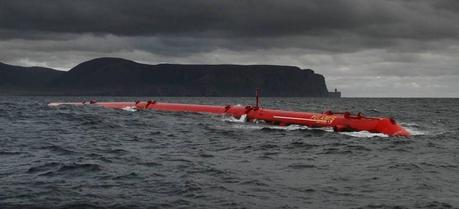 Pelamis Wave Energy Converter on site at the European Marine Energy Test Centre (EMEC).
Pelamis Wave Energy Converter on site at the European Marine Energy Test Centre (EMEC).There have been many attempts to use both wave and tidal energy for at least a century now, however, until recent times, this technologies have remained largely experimental. During the last few month we have seen several ocean energy projects ranging from experimental turbine design tests to full-scale commercial applications. There was also a number of theoretical works on various aspects of tidal power.
What is the difference between wave power and tidal power?
While both technologies are forms of hydropower, they differ from each other because they are derived from different sources of energy. As the name suggests, wave energy is the transport of energy by ocean surface waves, and the capture of that energy to do useful work, while tidal energy converts the energy of tides into useful forms of power. As waves are, in essence, generated by wind passing over the surface of the sea, wave power can be seen as an alternative way to harness wind energy. For that reason wave energy, just like wind energy, can have significant variation over shorter time scale and may require power management techniques and electrical grid energy storage technologies for its successful integration into the power grid. Tidal power is taken from the Earth’s oceanic tides, and since tidal forces are periodic variations in gravitational attraction exerted by celestial bodies, tidal energy generation is much more predictable. Both tidal and wave power are renewable.
All forms of power generation based on the kinetic energy of large bodies of moving water can be called by a single term “marine energy” or “ocean energy”. Marine energy includes marine current power, osmotic power (the energy available from the difference in the salt concentration between seawater and river water), ocean thermal energy and tidal energy.
In March Alstom—a large French multinational conglomerate which holds interests in the power generation and transport markets—has tested a new 1MW tidal power turbine at a test site located in Orkney, Scotland. Alstom’s tidal turbine consists of a three-bladed, pitch-controlled rotor, with a diameter measuring 18 meters (59 feet); a standard drivetrain and power electronics inside the nacelle. The turbine is easy to transport (due to its buoyancy), can rotate to reflect the direction of the tide and can change the pitch of the blades to control the load.
Detailed testing and analysis of this technology in different operational conditions will continue throughout 2013 over an 18 month period, in order to further improve tidal power technology. The next step is to install pilot arrays prior to full commercial production.
A less conventional turbine technology has been proposed by Swedish scientists. The experimental vertical-axis hydroelectric turbine has been successfully installed on the bottom of the Dal River in Sweden (March, 2013). If verified, new turbine design can be applied primarily to harness the power of ocean tides. It could, however, also be used in conjunction with traditional hydropower systems to extract more energy from the rivers. Inventors have already received an offer to use this technology to set up a power station in a lagoon in the Seychelles.
While tidal energy is abundant, there is a problem of finding the optimal locations for the new tidal facilities to ensure efficiency and to minimize operational hazards. That is made more difficult by the lack of measurement data that can be used to exactly evaluate tidal power potential of a specific location. Scientists at the Uppsala University in Sweden have partially solved this problem by showing that currently available water data can be used for estimating the movement speed of water and thereby the potential energy resource available in a particular area. For example, for tidal currents, the speed can be estimated by using the data from nautical charts and data on tidal water height. This work was done as a part of a larger, ongoing marine power research project. The goal of the project is to develop the simplest possible method to harvest energy from flowing water.
When it comes to commercializing marine energy and getting it to the market, the brightest recent example is the wave power project by Aquamarine Power—a wave energy company, which was founded in 2005 to commercialize a wave energy device concept known as the Oyster wave energy converter. Following a full approval from the Scottish Government at the end of May, 2013, Aquamarine Power announced its intention to start construction of a 40MW wave farm off the north-west coast of Lewis, Scotland. As of today, this is the world’s largest fully-permitted ocean energy site.
This last example shows that while most ocean energy technologies are still quite young and undeveloped, some of them have now reached the point where they are ready to be used commercially.
John Davenport
Thomas, K., Grabbe, M., Yuen, K., & Leijon, M. (2012). A Permanent Magnet Generator for Energy Conversion from Marine Currents: No Load and Load Experiments ISRN Renewable Energy, 2012, 1-7 DOI: 10.5402/2012/489379Lalander, E., Grabbe, M., & Leijon, M. (2013). On the velocity distribution for hydro-kinetic energy conversion from tidal currents and rivers Journal of Renewable and Sustainable Energy, 5 (2) DOI: 10.1063/1.4795398
